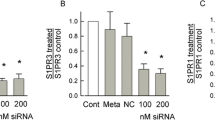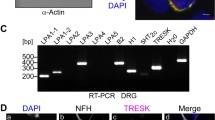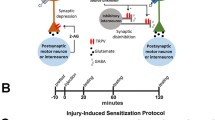Abstract
The endogenous lipid agent N-arachidonoylethanolamine (anandamide), among other effects, has been shown to be involved in nociceptive processing both in the central and peripheral nervous systems. Anandamide is thought to be synthesised by several enzymatic pathways both in a Ca2+-sensitive and Ca2+-insensitive manner, and rat primary sensory neurons produce anandamide. Here, we show for the first time, that cultured rat primary sensory neurons express at least four of the five known Ca2+-insensitive enzymes implicated in the synthesis of anandamide, and that application of 1,2-dioleoyl-sn-glycero-3-phosphoethanolamine-N-arachidonoyl, the common substrate of the anandamide-synthesising pathways, results in anandamide production which is not changed by the removal of extracellular Ca2+. We also show that anandamide, which has been synthesised in primary sensory neurons following the application of 1,2-dioleoyl-sn-glycero-3-phosphoethanolamine-N-arachidonoyl induces a transient receptor potential vanilloid type 1 ion channel-mediated excitatory effect that is not inhibited by concomitant activation of the cannabinoid type 1 receptor. Finally, we show that sub-populations of transient receptor potential vanilloid type 1 ion channel-expressing primary sensory neurons also express some of the putative Ca2+-insensitive anandamide-synthesising enzymes. Together, these findings indicate that anandamide synthesised by primary sensory neuron via a Ca2+-insensitive manner has an excitatory rather than an inhibitory role in primary sensory neurons and that excitation is mediated predominantly through autocrine signalling. Regulation of the activity of the Ca2+-insensitive anandamide-synthesising enzymes in these neurons may be capable of regulating the activity of these cells, with potential relevance to controlling nociceptive processing.








Similar content being viewed by others
References
Ahluwalia J, Urban L, Bevan S, Nagy I (2003) Anandamide regulates neuropeptide release from capsaicin-sensitive primary sensory neurons by activating both the cannabinoid 1 receptor and the vanilloid receptor 1 in vitro. Eur J Neurosci 17:2611–2618
Ahluwalia J, Urban L, Capogna M, Bevan S, Nagy I (2000) Cannabinoid 1 receptors are expressed in nociceptive primary sensory neurons. Neuroscience 100:685–688
Bisogno T, Di Marzo V (2010) Cannabinoid receptors and endocannabinoids: role in neuroinflammatory and neurodegenerative disorders. CNS Neurol Disord Drug Targets 9:564–573
Cadas H, Schinelli S, Piomelli D (1996) Membrane localization of N-acylphosphatidylethanolamine in central neurons: studies with exogenous phospholipases. Lipid Mediat. Cell Signal 14:63–70
Carrier EJ, Kearn CS, Barkmeier AJ, Breese NM, Yang W, Nithipatikom K, Pfister SL, Campbell WB, Hillard CJ (2004) Cultured rat microglial cells synthesize the endocannabinoid 2-arachidonylglycerol, which increases proliferation via a CB2 receptor-dependent mechanism. Mol Pharmacol 65:999–1007
Caterina MJ, Schumacher MA, Tominaga M, Rosen TA, Levine JD, Julius D (1997) The capsaicin receptor: a heat-activated ion channel in the pain pathway. Nature 389:816–824
Devane WA, Hanus L, Breuer A, Pertwee RG, Stevenson LA, Griffin G, Gibson D, Mandelbaum A, Etinger A, Mechoulam R (1992) Isolation and structure of a brain constituent that binds to the cannabinoid receptor. Science 258:1946–1949
Di Marzo V, Fontana A, Cadas H, Schinelli S, Cimino G, Schwartz JC, Piomelli D (1994) Formation and inactivation of endogenous cannabinoid anandamide in central neurons. Nature 372:686–691
Di Marzo V, De Petrocellis L (2010) Endocannabinoids as regulators of transient receptor potential (TRP) channels: a further opportunity to develop new endocannabinoid-based therapeutic drugs. Curr Med Chem 17:1430–1449
Di Marzo V, De Petrocellis L, Sepe N, Buono A (1996) Biosynthesis of anandamide and related acylethanolamides in mouse J774 macrophages and N18 neuroblastoma cells. Biochem J 316:977–984
Docherty RJ, Yeats JC, Piper AS (1997) Capsazepine block of voltage-activated calcium channels in adult rat dorsal root ganglion neurones in culture. Br J Pharmacol 121:1461–1467
Evans RM, Scott RH, Ross RA (2004) Multiple actions of anandamide on neonatal rat cultured sensory neurones. Br J Pharmacol 141:1223–1233
Fioravanti B, De Felice M, Stucky CL, Medler KA, Luo MC, Gardell LR, Ibrahim M Jr, Malan TP, Yamamura HI, Ossipov MH, King T, Lai J, Porreca F, Vanderah TW (2008) Constitutive activity at the cannabinoid CB1 receptor is required for behavioral response to noxious chemical stimulation of TRPV1: antinociceptive actions of CB1 inverse agonists. J Neurosci 28:11593–11602
Fischbach T, Greffrath W, Nawrath H, Treede RD (2007) Effects of anandamide and noxious heat on intracellular calcium concentration in nociceptive drg neurons of rats. J Neurophysiol 98:929–938
Goodfellow CE, Glass M (2009) Anandamide receptor signal transduction. Vitam Horm 81:79–110
Hermann H, De Petrocellis L, Bisogno T, Schiano-Moriello A, Lutz B, Di Marzo V (2003) Dual effect of cannabinoid CB1 receptor stimulation on a vanilloid VR1 receptor-mediated response. Cell Mol Life Sci 60:607–616
Jin XH, Uyama T, Wang J, Okamoto Y, Tonai T, Ueda N (2009) cDNA cloning and characterization of human and mouse Ca(2+)-independent phosphatidylethanolamine N-acyltransferases. Biochim Biophys Acta 1791:32–38
Jordt SE, Julius D (2002) Molecular basis for species-specific sensitivity to "hot" chili peppers. Cell 108:421–430
Lam PM, Marczylo TH, Konje JC (2010) Simultaneous measurement of three N-acylethanolamides in human bio-matrices using ultra performance liquid chromatography-tandem mass spectrometry. Anal Bioanal Chem 398:2089–2097
Leung D, Saghatelian A, Simon GM, Cravatt BF (2006) Inactivation of N-acyl phosphatidylethanolamine phospholipase D reveals multiple mechanisms for the biosynthesis of endocannabinoids. Biochemistry 45:4720–4726
Ligresti A, Petrosino S, Di Marzo V (2009) From endocannabinoid profiling to 'endocannabinoid therapeutics'. Curr Opin Chem Biol 13:321–331
Liu J, Wang L, Harvey-White J, Huang BX, Kim HY, Luquet S, Palmiter RD, Krystal G, Rai R, Mahadevan A, Razdan RK, Kunos G (2008) Multiple pathways involved in the biosynthesis of anandamide. Neuropharmacology 54:1–7
Liu J, Wang L, Harvey-White J, Osei-Hyiaman D, Razdan R, Gong Q, Chan AC, Zhou Z, Huang BX, Kim HY, Kunos G (2006) A biosynthetic pathway for anandamide. Proc Natl Acad Sci USA 103:13345–13350
Mahmud A, Santha P, Paule CC, Nagy I (2009) Cannabinoid 1 receptor activation inhibits transient receptor potential vanilloid type 1 receptor-mediated cationic influx into rat cultured primary sensory neurons. Neuroscience 162:1202–1211
Marsicano G, Wotjak CT, Azad SC, Bisogno T, Rammes G, Cascio MG, Hermann H, Tang J, Hofmann C, Zieglgänsberger W, Di Marzo V, Lutz B (2002) The endogenous cannabinoid system controls extinction of aversive memories. Nature 418:530–534
Matsuda LA, Lolait SJ, Brownstein MJ, Young AC, Bonner TI (1990) Structure of a cannabinoid receptor and functional expression of the cloned cDNA. Nature 346:561–564
Morisset V, Urban L (2001) Cannabinoid-induced presynaptic inhibition of glutamatergic EPSCs in substantia gelatinosa neurons of the rat spinal cord. J Neurophysiol 86:40–48
Nagy I (2004) Sensory processing: primary afferent neurons/DRG. In: Evers AS, Maze M (eds) Anesthetic pharmacology: physiologic principles and clinical practice. Churchill Livingstone, Philadelphia, pp 187–197
Nagy B, Fedonidis C, Photiou A, Wahba J, Paule CC, Ma D, Buluwela L, Nagy I (2009) Capsaicin-sensitive primary sensory neurons in the mouse express N-acyl phosphatidylethanolamine phospholipase D. Neuroscience 161:572–577
Nagy I, Pabla R, Matesz C, Dray A, Woolf CJ, Urban L (1993) Cobalt uptake enables identification of capsaicin- and bradykinin-sensitive subpopulations of rat dorsal root ganglion cells in vitro. Neuroscience 56:241–246
Nagy I, Rang HP (1999) Similarities and differences between the responses of rat sensory neurons to noxious heat and capsaicin. J Neurosci 19:10647–10655
Okamoto Y, Morishita J, Tsuboi K, Tonai T, Ueda N (2004) Molecular characterization of a phospholipase D generating anandamide and its congeners. J Biol Chem 279:5298–5305
Sántha P, Jenes A, Somogyi C, Nagy I (2010) The endogenous cannabinoid anandamide inhibits transient receptor potential vanilloid type 1 receptor-mediated currents in rat cultured primary sensory neurons. Acta Physiol Acad Sci Hung 97:149–159
Sathianathan V, Avelino A, Charrua A, Santha P, Matesz K, Cruz F, Nagy I (2003) Insulin induces cobalt uptake in a subpopulation of rat cultured primary sensory neurons. Eur J Neurosci 18:2477–2486
Selvarajah S, Chen J, Varga A, Brain S, White J P M, Urban L, Buluwela L, Nagy I (2012) The role of cannabinoid 1 receptor (CB1) in N-arachidonylethanolamine (anandamide) responsiveness of the transient receptor potential vanilloid type 1 ion channel (TRPV1) in cultured rat primary sensory neurons (PSN). Proceedings of the British Pharmacological Society at http://www.pa2online.org/abstract/Vol10Issue4abst107.pdf
Simon GM, Cravatt BF (2008) Anandamide biosynthesis catalyzed by the phosphodiesterase GDE1 and detection of glycerophospho-N-acyl ethanolamine precursors in mouse brain. J Biol Chem 283:9341–9349
Simon GM, Cravatt BF (2010) Characterization of mice lacking candidate N-acyl ethanolamine biosynthetic enzymes provides evidence for multiple pathways that contribute to endocannabinoid production in vivo. Mol Biosyst 6:1411–1418
Singh-Tahim S, Santha P, Nagy I (2005) Inflammatory mediators convert anandamide into a potent activator of the vanilloid type 1 transient receptor potential receptor in nociceptive primary sensory neurons. Neuroscience 136:539–548
Soneji ND, Paule CC, Mlynarczyk M, Nagy I (2010) Effects of cannabinoids on capsaicin receptor activity following exposure of primary sensory neurons to inflammatory mediators. Life Sci 87:162–168
Starowicz K, Di Marzo V (2013) Non-psychotropic analgesic drugs from the endocannabinoid system: "magic bullet" or "multiple target" strategies? Eur J Pharmacol. doi:10.1016/j.ejphar.2013.01.075
Sun YX, Tsuboi K, Okamoto Y, Tonai T, Murakami M, Kudo I, Ueda N (2004) Biosynthesis of anandamide and N-palmitoylethanolamine by sequential actions of phospholipase A2 and lysophospholipase D. Biochem J 380:749–756
Ueda N, Liu Q, Yamanaka K (2001) Marked activation of the N-acylphosphatidylethanolamine-hydrolyzing phosphodiesterase by divalent cations. Biochim Biophys Acta 1532:121–127
Ueda N, Tsuboi K, Uyama T (2013) Metabolism of endocannabinoids and related N-acylethanolamines: canonical and alternative pathways. FEBS J 280:1874–1894
van der Stelt M, Trevisani M, Vellani V, De Petrocellis L, Schiano Moriello A, Campi B, McNaughton P, Geppetti P, Di Marzo V (2005) Anandamide acts as an intracellular messenger amplifying Ca2+ influx via TRPV1 channels. EMBO J 24:3026–3037
Vellani V, Petrosino S, De Petrocellis L, Valenti M, Prandini M, Magherini PC, McNaughton PA, Di Marzo V (2008) Functional lipidomics. Calcium-independent activation of endocannabinoid/endovanilloid lipid signalling in sensory neurons by protein kinases C and A and thrombin. Neuropharmacology 55:1274–1279
Walker KM, Urban L, Medhurst SJ, Patel S, Panesar M, Fox AJ, McIntyre P (2003) The VR1 antagonist capsazepine reverses mechanical hyperalgesia in models of inflammatory and neuropathic pain. J Pharmacol Exp Ther 304:56–62
Wang J, Okamoto Y, Morishita J, Tsuboi K, Miyatake A, Ueda N (2006) Functional analysis of the purified anandamide-generating phospholipase D as a member of the metallo-beta-lactamase family. J Biol Chem 281:12325–12335
Wang J, Okamoto Y, Tsuboi K, Ueda N (2008) The stimulatory effect of phosphatidylethanolamine on N-acylphosphatidylethanolamine-hydrolyzing phospholipase D (NAPE-PLD). Neuropharmacology 54:8–15
White JPM, Calcott G, Jenes A, Hossein M, Paule CC, Santha P, Davis JB, Ma D, Rice ASC, Nagy I (2011) Xenon reduces activation of transient receptor potential vanilloid type 1 (TRPV1) in rat dorsal root ganglion cells and in human TRPV1-expressing HEK293 cells. Life Sci 88:141–149
Wood JN, Winter J, James IF, Rang HP, Yeats J, Bevan S (1988) Capsaicin-induced ion fluxes in dorsal root ganglion cells in culture. J Neurosci 8:3208–3220
Zygmunt PM, Petersson J, Andersson DA, Chuang H, Sørgård M, Di Marzo V, Julius D, Högestätt ED (1999) Vanilloid receptors on sensory nerves mediate the vasodilator action of anandamide. Nature 400:452–457
Acknowledgements
The authors are grateful to Professor Stuart Bevan and Dr David Andersson (King's College London, UK) for their help and support with the Ca2+-imaging experiments and their very useful and constructive comments. The authors are also grateful to Dr Ed Smith (Imperial College London, UK) for his help in the TLC study. Parts of this work were supported by a project grant from the Wellcome Trust (061637/Z/06/Z). Agnes Jenes was supported by a BJA/RCoA Project Grant. Angelika Varga has been supported by a European Union Marie Curie Intra-European Fellowship (254661). Joao Valente has been supported by a PhD studentship from Fundacao para a Ciencia e a Tecnologia (Portugal).
Author information
Authors and Affiliations
Corresponding author
Additional information
A. Varga and A. Jenes contributed equally to this work.
Electronic supplementary material
Below is the link to the electronic supplementary material.
ESM 1
(DOC 778 kb)
Rights and permissions
About this article
Cite this article
Varga, A., Jenes, A., Marczylo, T.H. et al. Anandamide produced by Ca2+-insensitive enzymes induces excitation in primary sensory neurons. Pflugers Arch - Eur J Physiol 466, 1421–1435 (2014). https://doi.org/10.1007/s00424-013-1360-7
Received:
Accepted:
Published:
Issue Date:
DOI: https://doi.org/10.1007/s00424-013-1360-7




